Christine Valters Paintner's Blog, page 134
April 18, 2015
Seeing the World Anew: Peace – Pilgrimage of Resurrection through Creative Practice (a love note)
This is the third in a series of eight reflections over the season of Easter on making a pilgrimage of resurrection.
Word for Today: Peace
In the gospel reading this Sunday, Jesus invites his disciples to see with new eyes. They are frightened and uncertain, because something so radically new is happening. They have grown accustomed to viewing the world in a certain way, but they are called to open their minds and their eyes in new ways.
The Gospels are filled with stories about seeing, or not seeing, as the case may be. On the road to Emmaus, a kind of pilgrimage, the disciples are walking with Jesus and breaking bread with him. We read that their “eyes were prevented from recognizing him.” When Jesus returns in resurrected form, he is fully embodied, yet hard for them to see clearly. The disciples do not expect their dear friend to be among them again and so they miss this truth with their limited vision.
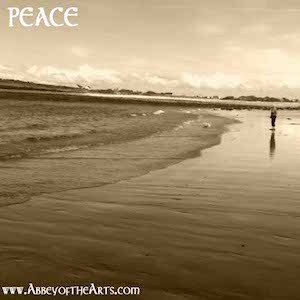 We find a similar emphasis on vision in the story of Jesus’ Transfiguration. The burning light that once appeared to Moses in the bush now radiates from Jesus himself: “His face shone like the sun.” For the ancient writer Gregory Palamas, it was the disciples who changed at the Transfiguration, not Christ. Christ was transfigured “not by the addition of something he was not, but by the manifestation to his disciples of what he really was. He opened their eyes so that instead of being blind they could see.” Because their perception grew sharper, they were able to behold Christ as he truly is.
We find a similar emphasis on vision in the story of Jesus’ Transfiguration. The burning light that once appeared to Moses in the bush now radiates from Jesus himself: “His face shone like the sun.” For the ancient writer Gregory Palamas, it was the disciples who changed at the Transfiguration, not Christ. Christ was transfigured “not by the addition of something he was not, but by the manifestation to his disciples of what he really was. He opened their eyes so that instead of being blind they could see.” Because their perception grew sharper, they were able to behold Christ as he truly is.
This speaks of an invitation to see the world in a different way. When we rush from thing to thing, never pausing, never allowing space, we see only what we expect to find. We see to grasp at the information we need. We see the stereotypes embedded in our minds. We miss the opportunity to see beyond what we want. We walk by a thousand ordinary revelations every day in our busyness and preoccupation.
We move through our lives, often at such speed, that our perception of time becomes contorted. We begin to believe that life is about rushing as fast as we can, about getting as much done as possible. We are essentially skating across life’s surface, exhausted, and disoriented.
You may have had an experience where you are moving through a most ordinary day, when suddenly something shifts. Where there was drudgery and habit, suddenly you become aware of the way sunlight is spilling across the living room rug and your heart breaks open at the splendor of it all. Or you see a loved one in a new way and revel in their beauty. Or maybe it is as simple as savoring the steam rising from your morning coffee like incense lifting the longings of your heart.
Contemplative practice calls us to change our perspective and awaken to a different reality, one that is governed by spaciousness, slowness, stillness, and presence. Contemplation invites us to tend the moments and see what is there, rather than what we expect.
Moments are holy doorways where we are lifted out of time and we encounter the sacred in the most ordinary of acts. Moments invite us to pause and linger because there is a different sense of time experienced. Moments are those openings we experience, where time suddenly loses its linear march and seems to wrap us in an experience of the eternal.
We are called to open ourselves to these moments of eternity, or better yet, how we allow the moment to find us. We only need to make ourselves available to them, to receive them as the gifts that they are, rather than seek them out as something we are entitled to have.
Our habitual ways of perceiving the world, which help us navigate things like stopping at a red light or stop sign, also stand in the way of seeing the world in fresh and new ways. So often, we are looking for information, rather than truly seeing.
I find inspiration in the ancient practice of lectio divina, or sacred reading. In lectio, we read scripture and listen for what word or phrase is shimmering. This practice is always in service of contemplative vision in daily life. Lectio invites us to slowly see more and more of the world as a sacred text, ripe with possibility for meaning. We can expand our contemplative practice to include a kind of visio divina, or sacred seeing, where we gaze on an icon or painting we love and look for something that shimmers – perhaps a symbol, a color, a brushstroke, the play of light and shadow. And in that shimmering we know there is a gift for us, even if we don’t fully understand its meaning in the moment.
We can then expand our practice of sacred seeing even further to include what we see all around us in our daily lives. What would it be like to move through our day, watching for what shimmers, waiting to receive these moments of revelation, and then savor them?
We are so used to moving through the world analyzing and judging, bringing our expectations to each encounter, planning for the next several steps ahead. It can feel awkward to bring ourselves fully present and draw on intuition, wisdom, and experience, rather than logic and analysis, to see what is most true. This heart-centered knowing comes through practice.
As I cultivate this practice of attending to the gifts the world has to offer me, to what shimmers, I am at the same time nurturing the opening of my own heart. Our minds harden our defenses, but the heart softens and blooms forth slowly, so that we find ourselves looking with more compassion on those who annoy us, and perhaps later, those we actively dislike, and finally those we have previously ignored and not even allowed into our line of sight.
When we discover ourselves surprised by love and grace, we come to trust what shimmers forth as gift. We receive without needing to figure things out. We begin to follow the thread of moment by moment revelation, not knowing where it leads, only embracing the call to see with eyes of the heart.
This is the gift of pilgrimage, of making a commitment to daily practice. Art-making can help us to see things in new ways. It calls us to drop below the surface of our experience and discover the new thing happening. How will you practice seeing the world with new eyes during this season of resurrection?
At Abbey of the Arts, we are inviting the community to make a commitment to practice creativity daily in celebration of my new book being released in May 2015 The Soul of a Pilgrim: Eight Practices for the Journey Within (Ave Maria Press). Please join us (details available at this post).
With great and growing love,
Christine
Christine Valters Paintner, PhD
Click here to read this post at Patheos and share with others>
April 18: Essence – Pilgrimage of Resurrection(A Creative Journey through the Easter Season)
Word for Today: Essence
 Anytime we have a desert experience in our lives, something is stripped away. It may be loss of possessions, loss of identity, or loss of a loved one….This stripping away forces us to return to the essence of things. We are thrust into the arms of what is most sacred to us.
Anytime we have a desert experience in our lives, something is stripped away. It may be loss of possessions, loss of identity, or loss of a loved one….This stripping away forces us to return to the essence of things. We are thrust into the arms of what is most sacred to us.
—Christine Valters Paintner, The Soul of a Pilgrim: Eight Practices for the Journey Within
Reflective Question: How can you practice this kind of letting go every day?
Next steps:
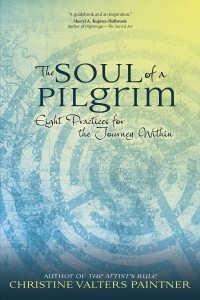 Let the word, quote, and question inspire your creative practice (Download the list of daily words here.) Use the hashtag #soulofapilgrim when sharing on social media.
Let the word, quote, and question inspire your creative practice (Download the list of daily words here.) Use the hashtag #soulofapilgrim when sharing on social media.Join the Holy Disorder of Dancing Monks Facebook group to share your art and writing with others.
Name your commitment to creative practice in the comments at this post (and enter the drawing to win a free copy of The Soul of a Pilgrim.)
Share this post with others and invite them to participate (they can sign up here)
Order a copy of Christine's newest book The Soul of a Pilgrim
Walk the Ancient Paths: Join us on pilgrimage to sacred landscapes>>
April 17, 2015
April 17: Beauty – Pilgrimage of Resurrection(A Creative Journey through the Easter Season)
Word for Today: Beauty
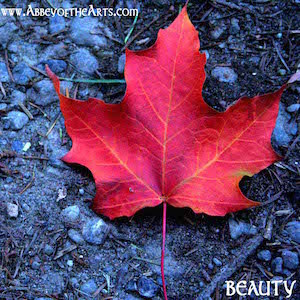 If we’re really honest with ourselves, in a world where terrible things happen there must be room made for doubt. We must give ourselves and others space to wrestle with the essential questions of our lives. Believing in times of beauty and transcendence leads us to the idea there must also be room for something bigger than what we traditionally call faith or belief.
If we’re really honest with ourselves, in a world where terrible things happen there must be room made for doubt. We must give ourselves and others space to wrestle with the essential questions of our lives. Believing in times of beauty and transcendence leads us to the idea there must also be room for something bigger than what we traditionally call faith or belief.
—Christine Valters Paintner, The Soul of a Pilgrim: Eight Practices for the Journey Within
Reflective Question: What are the unknown shores beckoning to you? Might you yield your resistance and desire for familiarity to step into the wide horizon of possibilities beyond your understanding?
Next steps:
 Let the word, quote, and question inspire your creative practice (Download the list of daily words here.) Use the hashtag #soulofapilgrim when sharing on social media.
Let the word, quote, and question inspire your creative practice (Download the list of daily words here.) Use the hashtag #soulofapilgrim when sharing on social media.Join the Holy Disorder of Dancing Monks Facebook group to share your art and writing with others.
Name your commitment to creative practice in the comments at this post (and enter the drawing to win a free copy of The Soul of a Pilgrim.)
Share this post with others and invite them to participate (they can sign up here)
Order a copy of Christine's newest book The Soul of a Pilgrim
Walk the Ancient Paths: Join us on pilgrimage to sacred landscapes>>
April 16, 2015
Monk in the World guest post: Karen Erlichman
I am delighted to share another beautiful submission for the Monk in the World guest post series from the community. Read on for Karen Erlichman's reflections on the connection between being a monk in the world and the Jewish practice of Mussar:
Being a Mussar Monk
In Judaism we don't have monks. I don’t even know if we have a Hebrew word for monk. We don't have monastic living; in fact, Jewish theology emphasizes engagement in the world, our human interconnectedness, and our obligation to partner with God in ongoing co-creation.
Jews do have many tools and practices that deepen our connection to God and the sacredness in everyday living. One of these practices is Mussar, a Jewish spiritual framework of ethical principles and spiritual practices that is thousands of years old.
The modern Mussar movement is based on the teachings of Rabbi Israel Salanter from Lithuania in the 1800s. Mussar is a psycho-spiritual system of contemplative self-evaluation, reflection and meditation that includes some solo practice, working with a study partner, and learning together in community. Alan Morinis, author of several contemporary books on Mussar and founder of the Mussar Institute, has unearthed Mussar from the wreckage of the Holocaust, where the Yeshiva religious communities that practiced Mussar were systematically annihilated by the Nazis.
Mussar practices guide people through working with middot (singular: middah), which translates as soul traits or soul qualities, by becoming aware of the habits, thoughts, and behaviors that obstruct or unblock the flow of divine light within each person. Some of these soul traits include humility, generosity, equanimity, compassion, forgiveness and trust, to name a few.
Tools and practices used in Mussar include meditation, journaling, study of sacred text, and chanting. Typically, Mussar practice is structured in four 13-week cycles over the course of a year, although it is also an ongoing life practice. Each person has their own “spiritual curriculum” that includes the particular soul traits and growing edges with which they are actively engaged using these tools and practices.
I have just started taking a class at the local Jewish Community Center called “Paying Attention: Shining Light on Real Life,” in which we are learning the practice of Mussar using the mindfulness practice of tikkun middot (healing soul traits), studying sacred text, and working in dyads with chevruta (learning partners).
The class meets every other week, and during the in-between week we connect with our chevruta partners. We are also encouraged to meditate and journal daily on the week’s topic. My particular interest and intention for the class is to create a somatically-based spiritual practice for Mussar–not just learning with words, ideas, meditation and dialogue but also with the body. Mindfulness meditation is rooted in the breath, which connects us to our bodies. The body is also an essential aspect of spiritual practice, one of our personal divination tools.
The first two sessions of the class gave us our conceptual foundation using two key ideas: Hitlamdut and Behira Points. Hebrew is such a rich language for spiritual practice because the grammatical system is very multidimensional. The term hitlamdut is the reflexive form of the verb that means to learn. Hitlamdut means to internalize what you learn, to breathe it in and be transformed by it. We spent the first session studying the concept of hitlamdut and immersing ourselves in an exploration of some ancient sacred texts on the topic.
I spent that first week with a morning practice using the word hitlamdut as a morning mantra, a reminder to engage every breath as present-moment of integrative learning. As the title of the class suggests, hitlamdut is about paying attention in a deeply spiritual way.
Week 2 was centered on the practice of Behira/Choice Points. The Hebrew word behira means choice or choosing, and behira/choice points are moments of awareness in which we consciously tap into our own growing edges and the path we choose in the present moment. A Behira point is like a spiritual crossroad in which we can ground ourselves in mindful awareness and step forward from that interior presence.
I have spent almost every day during the past week making a noble effort to say the words behira point to myself as often as possible throughout the day. Here is a soul snapshot from one particular day:
“I take a deep breath to empty my mind and drop down into the body. I direct my focus down into my belly, where the fulcrum of knowing what is true (this feels much better than right) meets my temptations and appetites.
Today I have an opportunity to practice anew. I have only one hour break in a very full day of clients. I have slept poorly all week. I have crappy shoes on. And my slothful yetzer hara (shadow side) wants to sit in the office and surf on Facebook. The part of me that knows what is true, that knows what is life-giving, offers up the idea of taking a walk. It’s a beautiful winter day, crisp invigorating breeze and bodacious sunshine. I feel the battle begin, and I remember our conversation in class about the behira point. I say the word to myself a few times while I change my shoes and put on the worn out but reliable old sneakers I keep in the closet in case of earthquakes. I leave my phone on the desk and trot down the stairs, swatting the yetzer hara like a persistent mosquito.
It takes a few blocks before I feel truly triumphant. I take the 4th avenue hill and feel my heart pound. As I turn the corner back toward my office, I can sense a change happening inside. My thoughts, emotions, connection to Spirit, inner body sensations and somatic engagement with creation—all of these are shifting and opening up to the Sacred in new ways.”
Blessed is the Holy One of Many Names, who has blessed me with this opportunity to stretch and grow in new ways. May I experience every new learning as an invitation to dive more deeply into the Mystery. Amen.
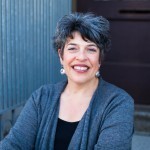 Karen Lee Erlichman, MSS, LCSW provides psychotherapy, spiritual direction, supervision and mentoring in San Francisco. Karen is the co-founder of Practistry, and completed Facilitator Preparation Training with the Center for Courage and Renewal under the leadership of Parker Palmer. Karen’s writing appears regularly on her blog, and has been published in Presence: An International Journal of Spiritual Direction. To find out more about Karen, visit her website: www.karenerlichman.com.
Karen Lee Erlichman, MSS, LCSW provides psychotherapy, spiritual direction, supervision and mentoring in San Francisco. Karen is the co-founder of Practistry, and completed Facilitator Preparation Training with the Center for Courage and Renewal under the leadership of Parker Palmer. Karen’s writing appears regularly on her blog, and has been published in Presence: An International Journal of Spiritual Direction. To find out more about Karen, visit her website: www.karenerlichman.com.
April 16: Simplicity – Pilgrimage of Resurrection(A Creative Journey through the Easter Season)
Word for Today: Simplicity
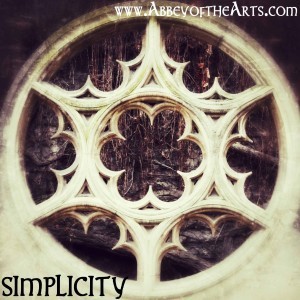 The invitation from the desert elders is to practice simplicity first. When we find this simplicity, they believed, we find true life.
The invitation from the desert elders is to practice simplicity first. When we find this simplicity, they believed, we find true life.
—Christine Valters Paintner, The Soul of a Pilgrim: Eight Practices for the Journey Within
Reflective Question: What brings you to life?
Next steps:
 Let the word, quote, and question inspire your creative practice (Download the list of daily words here.) Use the hashtag #soulofapilgrim when sharing on social media.
Let the word, quote, and question inspire your creative practice (Download the list of daily words here.) Use the hashtag #soulofapilgrim when sharing on social media.Join the Holy Disorder of Dancing Monks Facebook group to share your art and writing with others.
Name your commitment to creative practice in the comments at this post (and enter the drawing to win a free copy of The Soul of a Pilgrim.)
Share this post with others and invite them to participate (they can sign up here)
Order a copy of Christine's newest book The Soul of a Pilgrim
Walk the Ancient Paths: Join us on pilgrimage to sacred landscapes>>
April 15, 2015
April 15: Fasting – Pilgrimage of Resurrection(A Creative Journey through the Easter Season)
Word for Today: Fasting
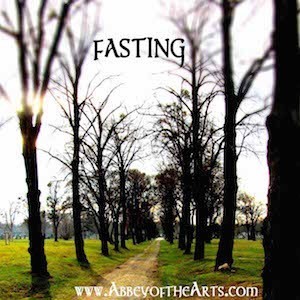 Fasting isn’t just for its own sake….Fasting is really an invitation to authentic freedom.
Fasting isn’t just for its own sake….Fasting is really an invitation to authentic freedom.
—Christine Valters Paintner, The Soul of a Pilgrim: Eight Practices for the Journey Within
Reflective question: What are the things in your life, from material possessions to personal beliefs, which weigh you down and restrict you, obscuring your search for God? What ideas about yourself keep you limited from everything you can be in your life?
Next steps:
 Let the word, quote, and question inspire your creative practice (Download the list of daily words here.) Use the hashtag #soulofapilgrim when sharing on social media.
Let the word, quote, and question inspire your creative practice (Download the list of daily words here.) Use the hashtag #soulofapilgrim when sharing on social media.Join the Holy Disorder of Dancing Monks Facebook group to share your art and writing with others.
Name your commitment to creative practice in the comments at this post (and enter the drawing to win a free copy of The Soul of a Pilgrim.)
Share this post with others and invite them to participate (they can sign up here)
Order a copy of Christine's newest book The Soul of a Pilgrim
Walk the Ancient Paths: Join us on pilgrimage to sacred landscapes>>
April 14, 2015
April 14: Freedom – Pilgrimage of Resurrection(A Creative Journey through the Easter Season)
Word for Today: Freedom
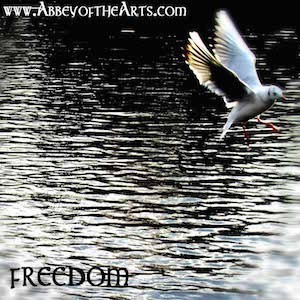 Asceticism, at its heart center, is about letting go of everything that keeps us from God and moving us along a journey toward authentic freedom.
Asceticism, at its heart center, is about letting go of everything that keeps us from God and moving us along a journey toward authentic freedom.
—Christine Valters Paintner, The Soul of a Pilgrim: Eight Practices for the Journey Within
Reflective Question: What things distract you from focusing on God? What can you do to increase the level of silence in your life so that you might hear God more clearly?
Next steps:
 Let the word, quote, and question inspire your creative practice (Download the list of daily words here.) Use the hashtag #soulofapilgrim when sharing on social media.
Let the word, quote, and question inspire your creative practice (Download the list of daily words here.) Use the hashtag #soulofapilgrim when sharing on social media.Join the Holy Disorder of Dancing Monks Facebook group to share your art and writing with others.
Name your commitment to creative practice in the comments at this post (and enter the drawing to win a free copy of The Soul of a Pilgrim.)
Share this post with others and invite them to participate (they can sign up here)
Order a copy of Christine's newest book The Soul of a Pilgrim
Walk the Ancient Paths: Join us on pilgrimage to sacred landscapes>>
April 13, 2015
April 13: Discern – Pilgrimage of Resurrection(A Creative Journey through the Easter Season)
Word for Today: Discern Pilgrimage demands preparation. There is much letting go that needs to happen. Packing bags means we need to discern what to carry with us and what to leave behind. This is one of the great gifts of pilgrimage; an invitation to discern what is essential.
Pilgrimage demands preparation. There is much letting go that needs to happen. Packing bags means we need to discern what to carry with us and what to leave behind. This is one of the great gifts of pilgrimage; an invitation to discern what is essential.
—Christine Valters Paintner, The Soul of a Pilgrim: Eight Practices for the Journey Within
Reflective Question: What keeps you from the great adventure life is calling you to? What kinds of attitudes, beliefs, expectations and stories you tell about yourself need to be released to travel more lightly?
Next steps:
 Let the word, quote, and question inspire your creative practice today. (Download the list of daily words here.) Use the hashtag #soulofapilgrim when sharing on social media.
Let the word, quote, and question inspire your creative practice today. (Download the list of daily words here.) Use the hashtag #soulofapilgrim when sharing on social media.Join the Holy Disorder of Dancing Monks Facebook group to share your art and writing with others.
Name your commitment to creative practice in the comments at this post (and enter the drawing to win a free copy of The Soul of a Pilgrim.
Share this post with others and invite them to participate (they can sign up here)
Order a copy of Christine's newest book The Soul of a Pilgrim
Walk the Ancient Paths: Join us on pilgrimage to sacred landscapes>>
April 11, 2015
The Holy Call of Doubt: See – Pilgrimage of Resurrection through Creative Practice (a love note)
This is the second in a series of eight reflections over the season of Easter on making a pilgrimage of resurrection.
Word for today: See
“Unless I see the mark of the nails in his hands
and put my finger into the nail marks
and put my hand into his side, I will not believe.” — John 20:24-25
"Christ is risen. He is risen indeed. We joyfully announce it. [And yet] I realize that my faith and unbelief are never far from each other. Maybe it is exactly at the place where they touch each other that the growing edge of my life is." — Henri Nouwen
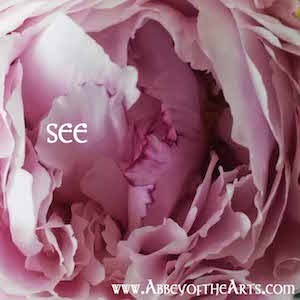 When we set out on pilgrimage, we often feel full of hope and possibility. When we begin our creative practice, we may feel fully committed to daily art-making. Then life intervenes. We have a difficult day, our car breaks down, the bills start piling up, or we get sick with a cold that is difficult to shake. Or more challenging, someone close to us is seriously ill. A family member starts demanding more attention.
When we set out on pilgrimage, we often feel full of hope and possibility. When we begin our creative practice, we may feel fully committed to daily art-making. Then life intervenes. We have a difficult day, our car breaks down, the bills start piling up, or we get sick with a cold that is difficult to shake. Or more challenging, someone close to us is seriously ill. A family member starts demanding more attention.
A pilgrimage of resurrection does not mean we deny the reality of life’s challenges and suffering. It calls us to enter whole-heartedly into whatever life brings us, paying attention to the invitation of each moment. Sometimes resurrection feels very far away and we cry out for some sort of proof that life is fundamentally good and that beauty sustains all things. This is why I love the story of Thomas.
Over eleven years ago my mother died quite suddenly. I was with her those last five days of her life in the ICU, in that dreadful and holy threshold space where death beckoned. In the year that followed I was filled with grief at the hollowness that loss had created in me. The second year I had hoped would begin to ease but in some ways was even more challenging than the first. I still had the ache of sorrow but also a deep doubt had emerged in my prayer and reflection. They were the doubts of someone who loved deeply and wanted to understand why death is woven into the fabric of the universe, the doubts of someone angry with God.
The theological framework that had sustained me for many years began to unravel. I had wrestled with this question of suffering and death before, but this doubt felt different. I sometimes felt like I was hovering on the edge of a dark canyon. Sometimes, too, life felt unbearably sweet and beautiful. Both were present in my days. I am grateful that I had the support of my husband and friends, and especially my spiritual director who encouraged me to stay with those places of doubt and darkness. He wisely counseled that moving toward my doubt and staying present was the only way to understand it, to eventually walk through to the other side. I was given permission in our time together to not try and figure out what I believed but to experience what was true for me.
I found being in nature profoundly healing and creative expression essential. The wild spaces of creation – both inner and outer – offered me a place to be with my unknowing, to rest into mystery without having to try and figure things out. Wildness is hard to pin down, that is its gift. It offers us the unexpected when we set aside our expectations about how the world works. I also found art-making to be a profound place of being able to work with my doubts in color and shape, rather than deny them.
The gifts for me of embracing doubt as a spiritual practice have been many. I have grown in my capacity to rest into the tensions of life. I question long-held assumptions. I am more embracing of mystery. Being with doubt takes courage, especially when the world around us wants us to have certainty again.
If we’re really honest with ourselves, in a world where terrible things happen, there must be room made for doubt, for wrestling honestly and fiercely with the essential questions of our lives. And if we’re still being honest with ourselves, in a world where beautiful and transcendent things happen, there must also be room for something bigger than what we traditionally call faith or belief, it is a deeper kind of knowing, one that emerges from blood and bone. Those moments where we finally feel at home in the world and can breathe deeply.
One of the many reasons I love monastic spirituality and am a Benedictine Oblate is I find in this path a call to practice hospitality, humility, contemplative ways of being, a movement toward radical simplicity, and service shaped by love. I don't have to "believe" something in particular, but practice is the heart of things. I can doubt and still practice. Practice is embodied, much the way that Thomas wanted to touch the wounds. Practice helps me to be in touch with the incarnational realities of my life.
Is my practice of the enlivening and transforming power of creativity embodied in how I actually perform the daily tasks of my day? Do I enflesh the things I say I value most?
These are some of the questions which pilgrimage asks us to consider. Art-making is one way to live into an answer.
At Abbey of the Arts, we are inviting the community to make a commitment to practice creativity daily in celebration of my new book being released in May 2015 The Soul of a Pilgrim: Eight Practices for the Journey Within (Ave Maria Press). Please join us (details available at this post).
With great and growing love,
Christine
Christine Valters Paintner, PhD
Click here to read this post at Patheos and share with others>
April 11: Pause – Pilgrimage of Resurrection(A Creative Journey through the Easter Season)
 Word for today: Pause
Word for today: Pause
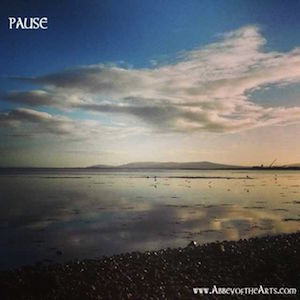 The monk in the world knows that holy pauses are essential for discovering the meaning of our experiences. There is no map. We can only drop deep into our hearts to guide us through our next steps.
The monk in the world knows that holy pauses are essential for discovering the meaning of our experiences. There is no map. We can only drop deep into our hearts to guide us through our next steps.
—Christine Valters Paintner, The Soul of a Pilgrim: Eight Practices for the Journey Within
Reflective Question: Reflective Question: Where do you find space for silence and solitude so that you can listen to the whisperings within?
Next steps:
 Let the word, quote, and question inspire your creative practice today. (Download the list of daily words here.) Use the hashtag #soulofapilgrim when sharing on social media.
Let the word, quote, and question inspire your creative practice today. (Download the list of daily words here.) Use the hashtag #soulofapilgrim when sharing on social media.Join the Holy Disorder of Dancing Monks Facebook group to share your art and writing with others.
Name your commitment to creative practice in the comments at this post (and enter the drawing to win a free copy of The Soul of a Pilgrim.
Share this post with others and invite them to participate (they can sign up here)
Order a copy of Christine's newest book The Soul of a Pilgrim
Walk the Ancient Paths: Join us on pilgrimage to sacred landscapes>>




